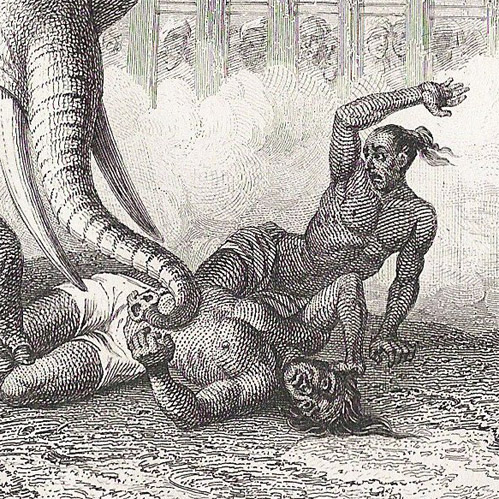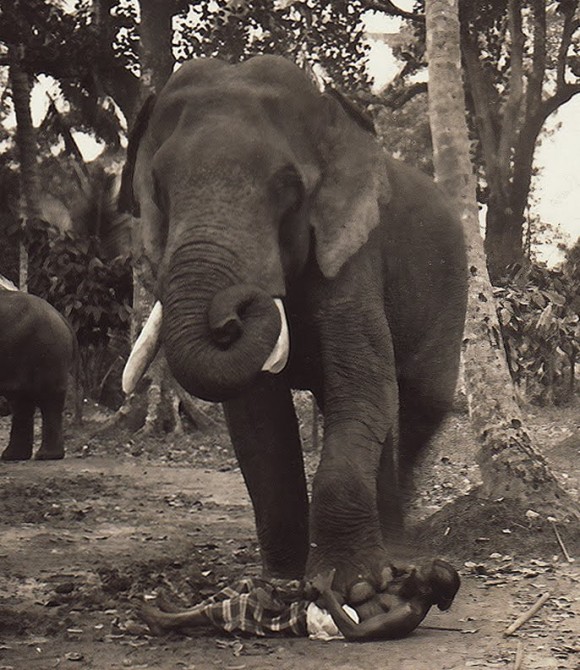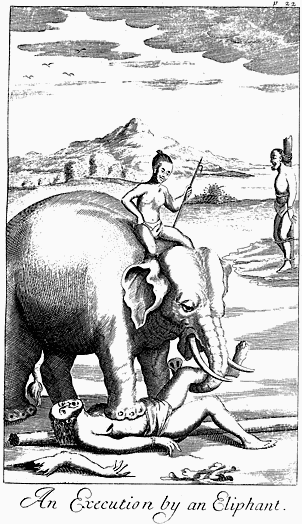India

Elephants were a popular execution method by Muslims and Hindus alike. Even fairly minor infractions like evading taxes and theft could end up finding you “under the feet of elephants”. Captain Alexander Hamilton, writing in 1727, described how the Mughal ruler Shah Jahan ordered an offending military commander to be carried “to the Elephant Garden, and there to be executed by an Elephant, which is reckoned to be a shameful and terrible Death”.
Sometimes these executions would be considered amusing entertainment, in one instance a whole horde of Mongols was publicly executed by elephants for a celebratory crowd. Another Mughal ruler, the emperor Jahangir, is said to have ordered a huge number of criminals to be crushed simply for his amusement.

The Muslim traveller Ibn Battuta, visiting Delhi in the 1330’s left us with this account of events:
“Upon a certain day, when I myself was present, some men were brought out who had been accused of having attempted the life of the Vizier. They were ordered, accordingly, to be thrown to the elephants, which had been taught to cut their victims to pieces. Their hoofs were cased with sharp iron instruments, and the extremities of these were like knives. On such occasions the elephant-driver rode upon them: and, when a man was thrown to them, they would wrap the trunk about him and toss him up, then take him with the teeth and throw him between their fore feet upon the breast, and do just as the driver should bid them, and according to the orders of the Emperor. If the order was to cut him to pieces, the elephant would do so with his irons, and then throw the pieces among the assembled multitude: but if the order was to leave him, he would be left lying before the Emperor, until the skin should be taken off, and stuffed with hay, and the flesh given to the dogs”.

The elephants that carried out the executions were kept separately from the other working animals. They were generally the biggest elephants that the ruler could find and were specifically trained for the job. Here’s another account of one such torture-and-execution at Baroda in 1814 which shows the sickening variety used in this methodology:
“The man was a slave, and two days before had murdered his master, brother to a native chieftain, called Ameer Sahib. About eleven o’clock the elephant was brought out, with only the driver on his back, surrounded by natives with bamboos in their hands. The criminal was placed three yards behind on the ground, his legs tied by three ropes, which were fastened to a ring on the right hind leg of the animal. At every step the elephant took, it jerked him forward, and every eight or ten steps must have dislocated another limb, for they were loose and broken when the elephant had proceeded five hundred yards. The man, though covered in mud, showed every sign of life, and seemed to be in the most excruciating torments. After having been tortured in this manner for about an hour, he was taken to the outside of the town, when the elephant, which is instructed for such purposes, was backed, and put his foot on the head of the criminal”.
As the Brits took control over more and more of the Asian continent the practice was banned and slowly died out. To be honest it’s the elephants I feel sorry for.
☛ Read Next: Most Brutal Execution Methods #5: Disembowelment















